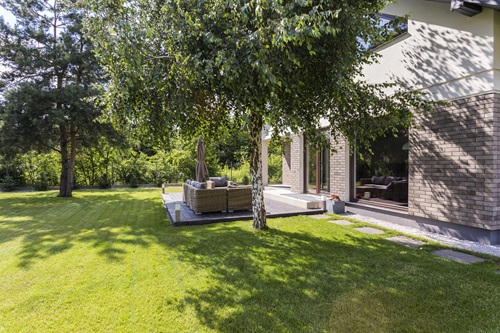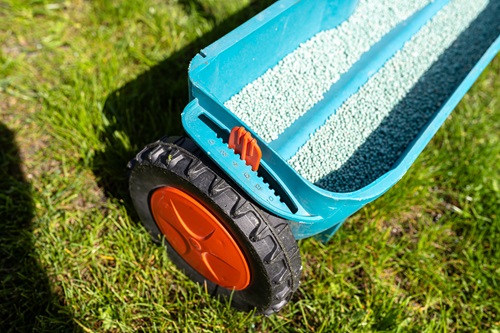
Lawn care can be a challenge, especially if parts of your yard are often in the shade. Whether you have tall trees, a garden shed, or large fences casting shadows, shaded areas tend to struggle with grass growth. However, this doesn’t mean you’re stuck with bare or patchy spots. By choosing the right grass seed and following a few key care tips, you can transform those shaded areas into a beautiful part of your lawn.
Lawn Care: How Shade Impacts Grass Growth
Before diving into the best grasses for shaded areas, it’s important to understand why grass struggles in low light. Grass, like all plants, relies on sunlight for photosynthesis. Without enough sunlight, grass can:
- Grow slowly
- Become thin and weak
- Develop shallow root systems
- Be more prone to disease
- Struggle to recover from stress, like foot traffic or drought
For this reason, areas with limited sunlight will need grass species that are more tolerant of shade.
Choosing the Best Grass for Shaded Areas
When selecting grass seed, it’s helpful to know whether you’re dealing with cool-season or warm-season grasses. Cool-season grasses thrive in regions with cold winters, while warm-season grasses are better suited for hot climates. Let’s explore the best grass types for both categories.
Lawn Care For Cool-Season Grasses for Shade
If you live in an area that experiences cold winters, cool-season grasses will be your best bet. Here are a few popular options:
Fescue
Fescue is an excellent choice for shaded lawns. Not only does it tolerate low light, but it also has a deep green color and fine texture. Fescue can be mixed with other shade-tolerant grasses to create a dense, healthy lawn.
Perennial Ryegrass
Another great option for cool-season lawns is perennial ryegrass. It establishes quickly and handles moderate foot traffic well. Although it can tolerate light to moderate shade, it may struggle in deeply shaded areas.
Rough Bluegrass
For areas with significant shade, rough bluegrass is one of the most shade-tolerant grasses available. It thrives in moist, shaded conditions, making it a strong option if your lawn in Conway SC experiences consistent shade.
Lawn Care For Warm-Season Grasses for Shade
If your region has hot summers and mild winters, warm-season grasses will perform better in your yard. These grasses thrive in the heat, but some are also able to tolerate shade:
St. Augustine
St. Augustine grass is well-known for its ability to grow in partial shade. With its broad, flat blades, it creates a dense, carpet-like appearance. It also works well in a range of soil types, making it a versatile choice.
Centipede Grass
For those seeking a low lawn maintenance option, centipede grass is a great pick. This light green grass grows slowly, meaning less mowing, and thrives in partially shaded areas. However, it still needs a few hours of sunlight each day to stay healthy.
Zoysia Grass
Zoysia grass is another top performer in shady lawns. Its dense, thick turf holds up well in partial shade, though it still prefers areas with some sunlight. Zoysia is often prized for its resilience and slow-growing nature, which means less frequent mowing.
Lawn Care For Grass in Shaded Areas
Once you’ve selected the best grass for your shaded areas, proper lawn care with the help of experts from Conners Lawn Care will help it thrive. Even shade-tolerant grasses need extra attention to grow strong and healthy. Here are some tips for maintaining grass in low-light areas.
Observe Your Lawn’s Sunlight Patterns
Begin by assessing how much sunlight different areas of your lawn receive throughout the day. Areas that get three to six hours of sunlight daily are considered “partially shaded.” These are the spots where shade-tolerant grasses will do their best. Identifying these patterns helps you choose the best planting locations.
Trim Nearby Trees and Shrubs
One easy way to help your shaded grass is by trimming trees and shrubs that block sunlight. Even trimming a few branches can let in more light, which will encourage healthier grass growth.
Water Less Frequently
Shaded areas of your lawn don’t dry out as quickly as sunny spots. Therefore, you won’t need to water them as often. Overwatering shaded grass can lead to soggy soil and potential root problems. Instead, adjust your watering schedule and let the soil dry out a bit between waterings.
Fertilize Less in Shaded Spots
Grass in shaded areas grows more slowly than grass in sunny spots, meaning it doesn’t need as much fertilizer. Too much fertilizer can stress the grass and cause issues like weak root growth. Use less fertilizer in shaded sections to keep the grass healthy and balanced.
Hire A Lawn Care Expert
Growing a beautiful lawn in shaded areas requires the right approach, but it’s entirely possible with the right grass and regular lawn care in Conway SC. If you’re unsure which grass seed is best for your shaded lawn or need help with planting, don’t hesitate to seek professional advice.
Looking to transform your shady spots into a lush, green lawn? Call Conner’s Lawn Care Service today to learn more about the best grass seed for your yard and take the first step toward a healthier, more vibrant lawn!
Conner’s Lawn Care Service
Myrtle Beach, SC
843-504-4901
http://connerslawncare.com/


No comments:
Post a Comment